
LexisNexis® Risk Classifier - Stratifying Mortality Risk Using Alternative Data Sources
properties.trackTitle
properties.trackSubtitle
Predictive models and life insurance
Munich Re assessed LexisNexis® Risk Classifier, a predictive modeling tool developed and owned by LexisNexis® Risk Solutions, Inc. that accurately stratifies mortality risk using public records, consumer credit history and motor vehicle history. Insurers considering alternative data-based mortality scores should begin with a retrospective validation study on their own experience data.Munich Re can assist carriers with the retrospective study, advise on changes to mortality assumptions and recommend how to incorporate Risk Classifier to streamline underwriting.
Executive summary
The LexisNexis® Risk Classifier Score is a proprietary scoring algorithm that includes public records, credit information and motor vehicle history to predict the relative mortality risk of individuals. Risk Classifier assigns a score ranging from 200 to 997, where high scores represent better relative mortality and low scores reflect worse mortality.
LexisNexis provided to Munich Re 8 million records sampled from a pool of property and casualty insur-ance shoppers. Munich Re reviewed the sample, validated the results, and confirmed that the scores produced by the model are predictive of mortality for the insurance shoppers. Life insurers interested in Risk Classifier should conduct a retrospective study in order to calibrate Risk Classifier to the carrier’s own underwriting paradigm. This process will help carriers balance the score with expected mortality with respect to their unique target markets, distribution channels, and other underwriting tools.
Methodology
Munich Re assessed the effective-ness of Risk Classifier in stratifying the mortality risk profile of a pool of 8 million insurance shoppers with entry ages 18-90. Each life entered the study between the start of 2006 and the end of 2010. Due to known lag in the reporting of deaths, the study end date was set to December 31, 2013. The study population is comprised of 187,836 deaths out of 42 million exposed life-years. The death information is from multiple sources, including the Social Security Death Master File (SSDMF), state deceased records and other LexisNexis® Risk Solutions proprietary sources.
The expected mortality basis was taken from the 2008 VBT primary ultimate ANB tables split by age and gender with a 1 percent mortality improvement. As we did not have the smoking status of each applicant, we used a 85 percent/15 percent non-smoker/smoker blend of the smoker distinct tables.
Munich Re completed analyses of relative actual to expected deaths (A/E) by age, gender, duration and wealth level to assess how the mortality risk stratification by Risk Classifier is influenced by these factors. In addition, we also received and reviewed several credit and public records attributes for each life.
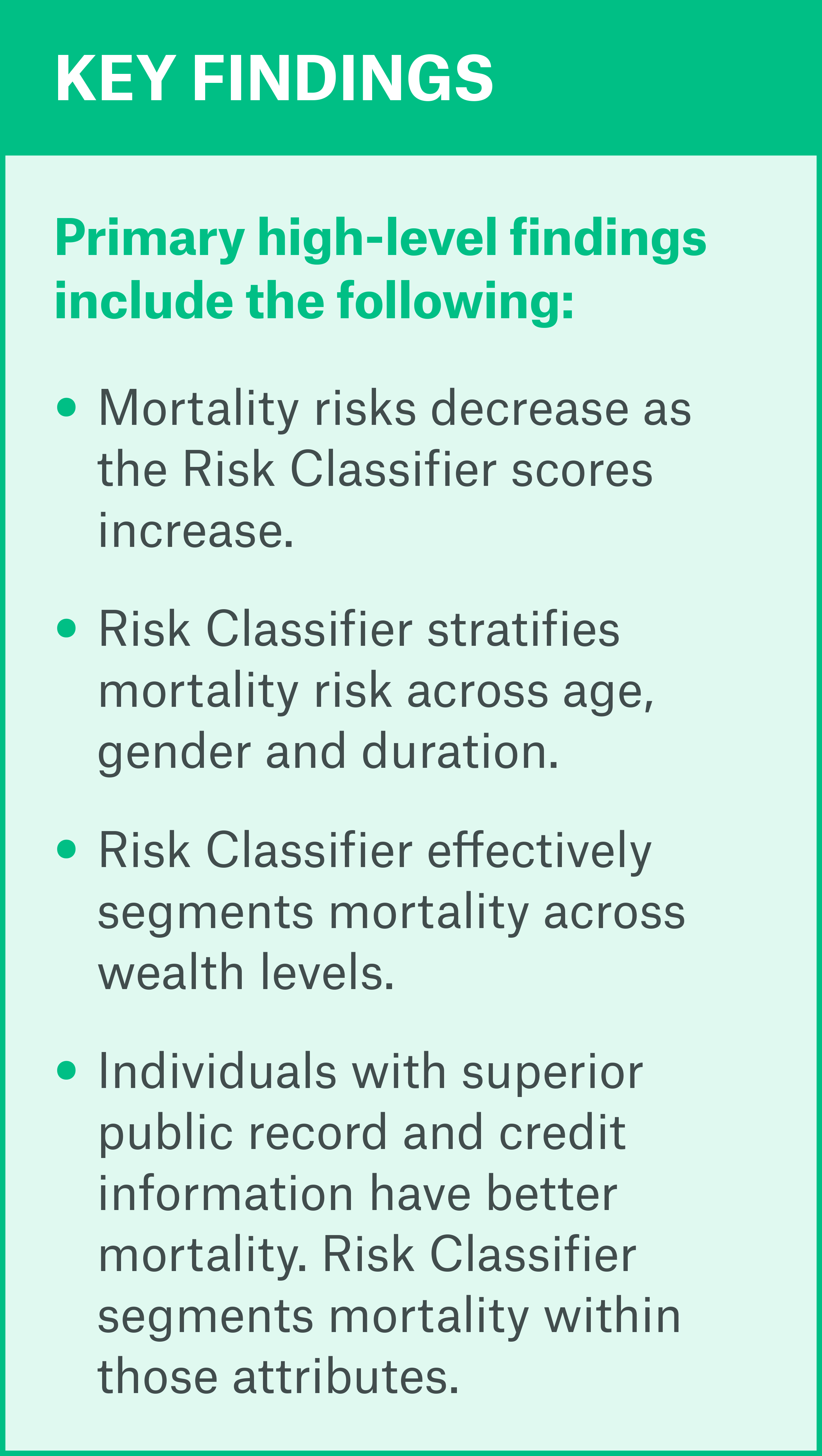
Overall results
Figure 1 provides a high level overview of the validation that the Risk Classifier stratifies mortality risk. Lives with lower Risk Classifier scores have higher mortality risk, while higher Risk Classifier scores correspond to lower mortality risk.
Age
Risk Classifier effectively segments mortality across all ages bands as seen in Figure 2. All age groups follow the same pattern, where mortality risk decreases as the Risk Classifier Score increases. From the chart, we observe that lives with ages greater than 70 have less relative mortality differentiation between low scores and high scores (flatter curve) compared to the other age groups.
Figure 3 shows the distribution of Risk Classifier scores within each age group. We observe that there is a spread of Risk Classifier scores across all age bands and, except for the age ≤ 30 group, the proportion of higher scores increases as age increases. This means that the average Risk Classifier Score is higher at older ages for this specific dataset.
Duration
From Figure 4, we can see that the effectiveness of Risk Classifier is consistent for varying durations.
Wealth
LexisNexis Risk Solutions provided an estimate of wealth for some individuals through a wealth index field. For the 56 percent of individuals with wealth data, one of six levels of a wealth index is assigned. The wealth index is calculated using the relative value of real property, watercraft, and aircraft assets on file associated with the consumer, currently and historically. No self-reported sources are used, but current property values are estimated based on the recorded sale price of the most recent property deed transfer, the most recent tax assessment value, and the market value on the tax assessor’s record.
Munich Re combined neighboring categories to classify applicants into low, medium and high wealth categories. Figure 5 shows the distribution of Risk Classifier scores within each wealth category. We observe that the propor-tion of high Risk Classifier scores increases as wealth level increases. This means that the average Risk Classifier score is the highest in the high wealth category.
Figure 6 demonstrates that Risk Classifier stratifies mortality risk regardless of wealth category. All wealth categories follow the same pattern, where mortality risk decreases as Risk Classifier scores increase. Note that the difference in trend for applicants with low wealth for scores between 900 and 997 is most likely due to the low number of deaths (<5 deaths) in that group.
Public record and credit attributes
LexisNexis Risk Solutions provided several public records and credit attributes for each life. We reviewed these attri-butes and observed that customers with superior public records and credit history informa-tion have better relative mortality. The table at right illustrates the rela-tionship between these attributes and relative mortality.
Total Amount of Past Due Balances represents the cumulative outstanding balances across all accounts reported on a credit file. As Figure 7 illustrates, the 31 percent of lives with a non-zero past due balance have much higher relative mortality compared to those with no past due balances.
Figure 8 demonstrates that Risk Classifier continues to segment mortality across total amount of past due balances.
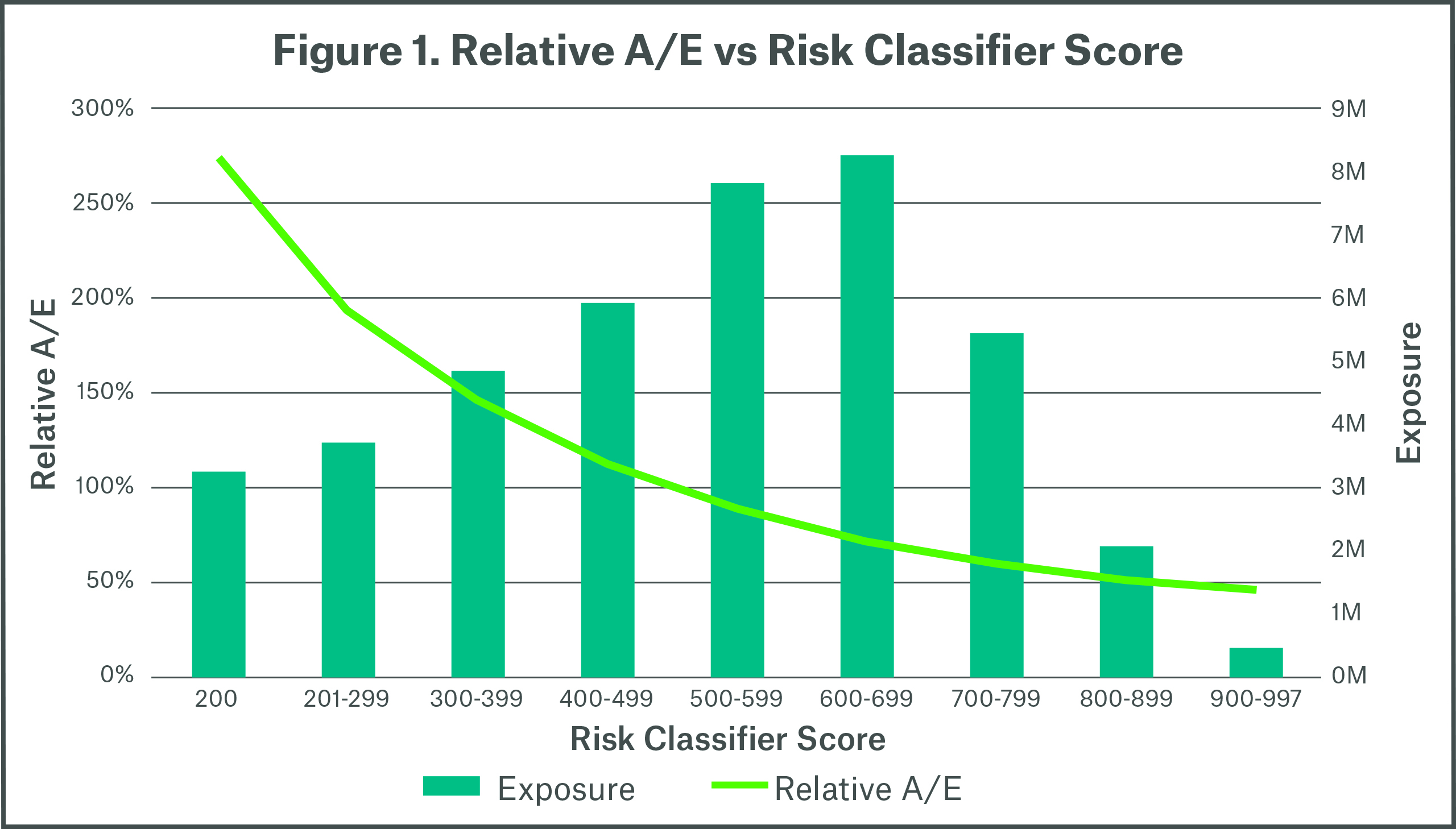
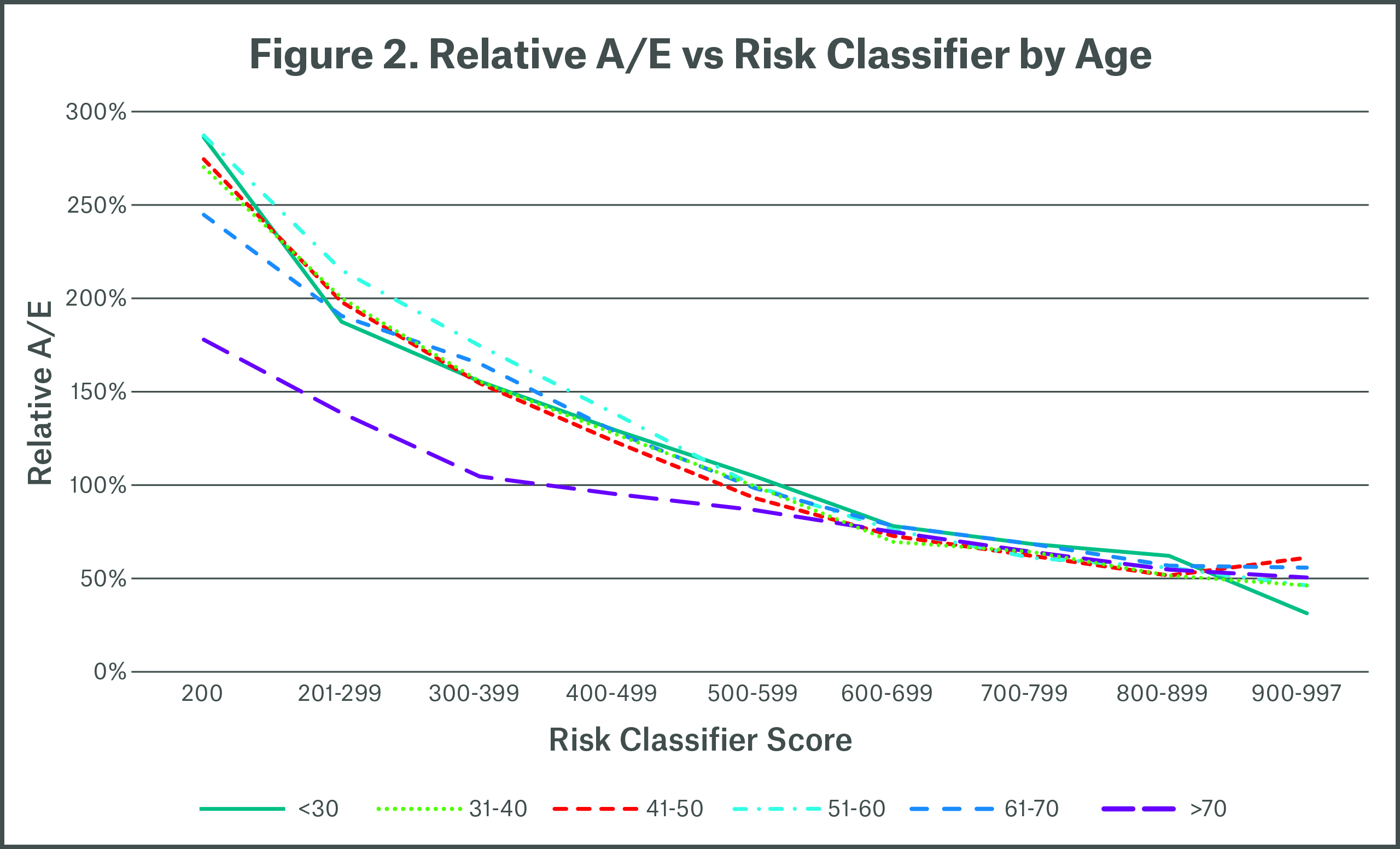
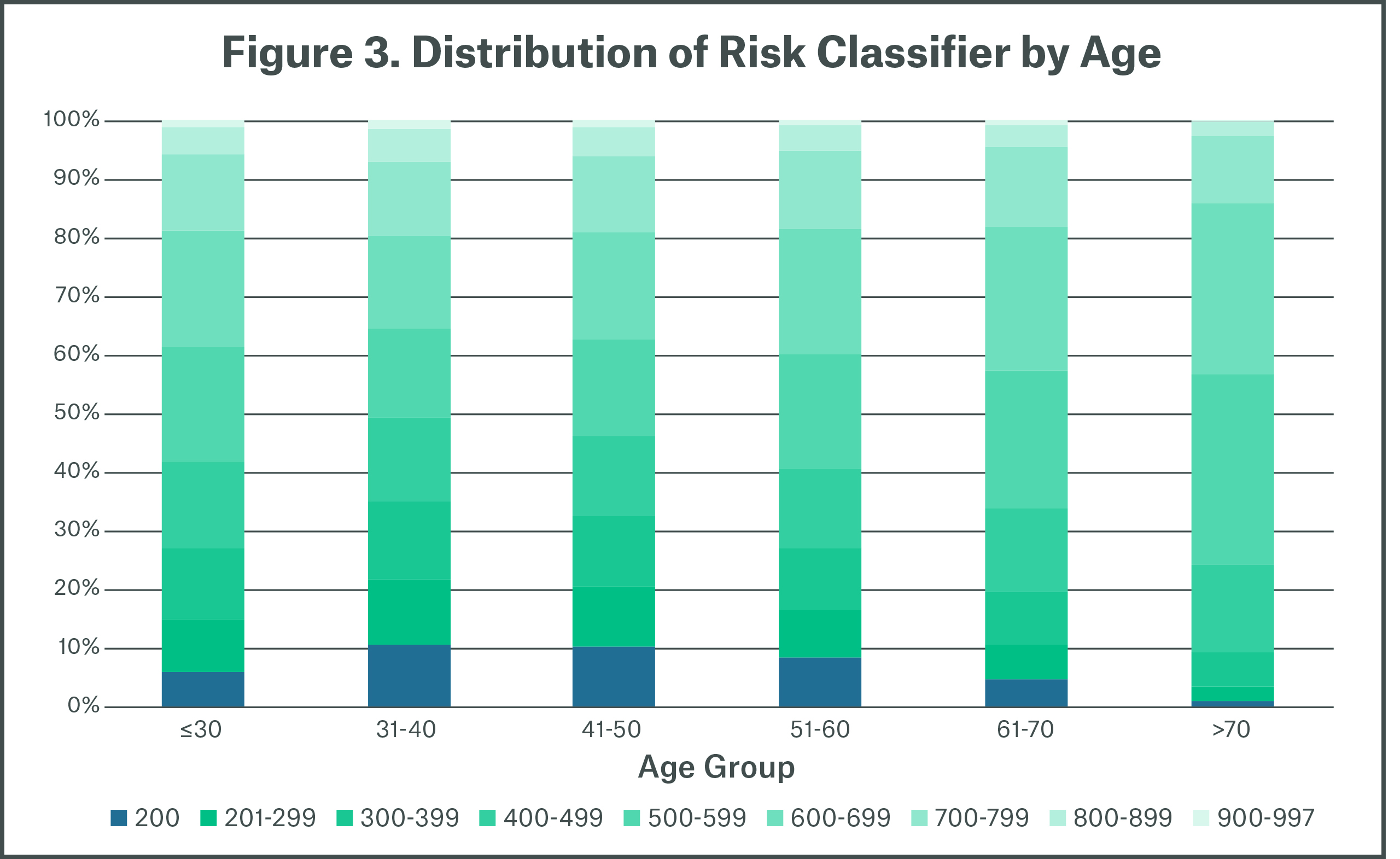
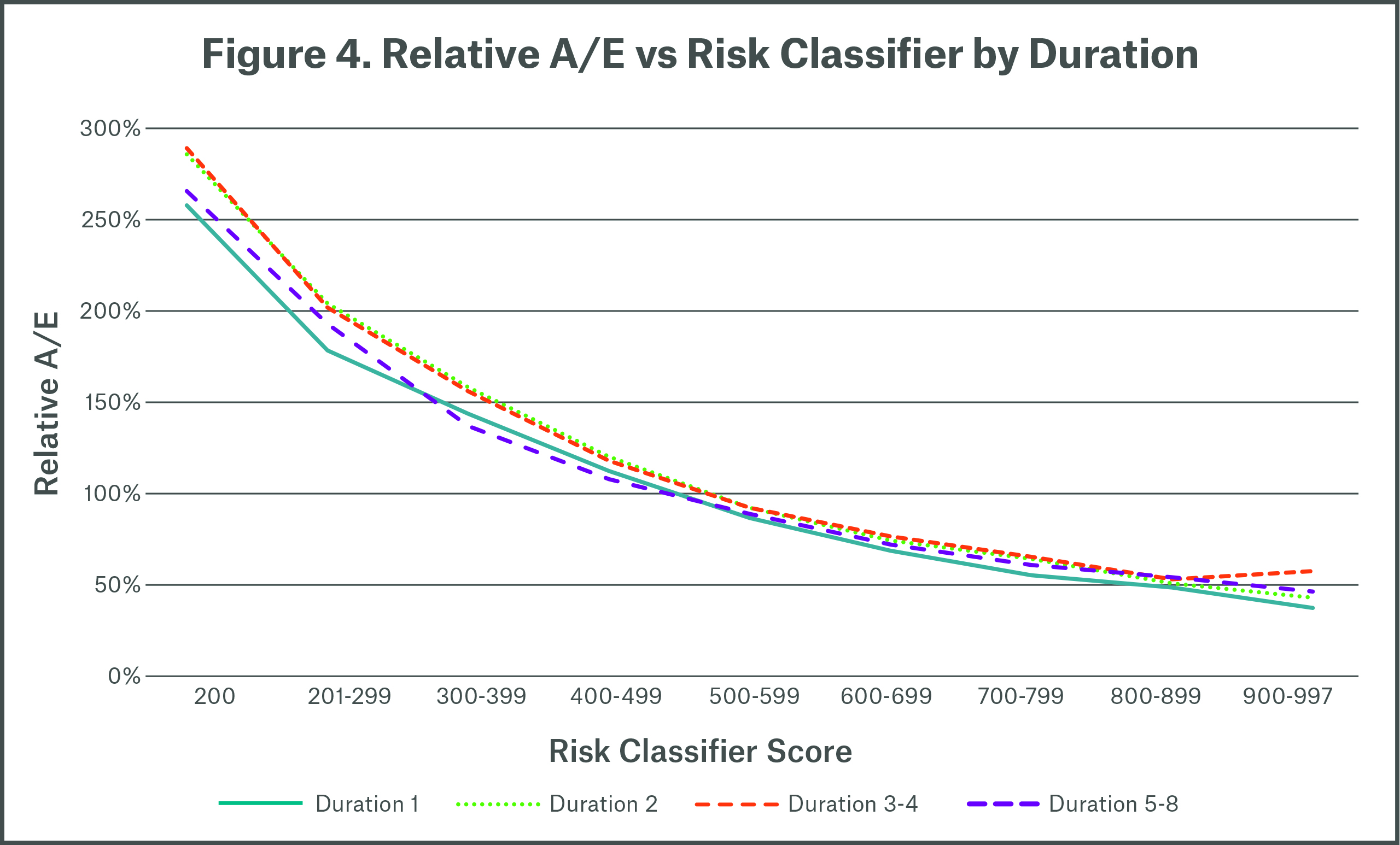
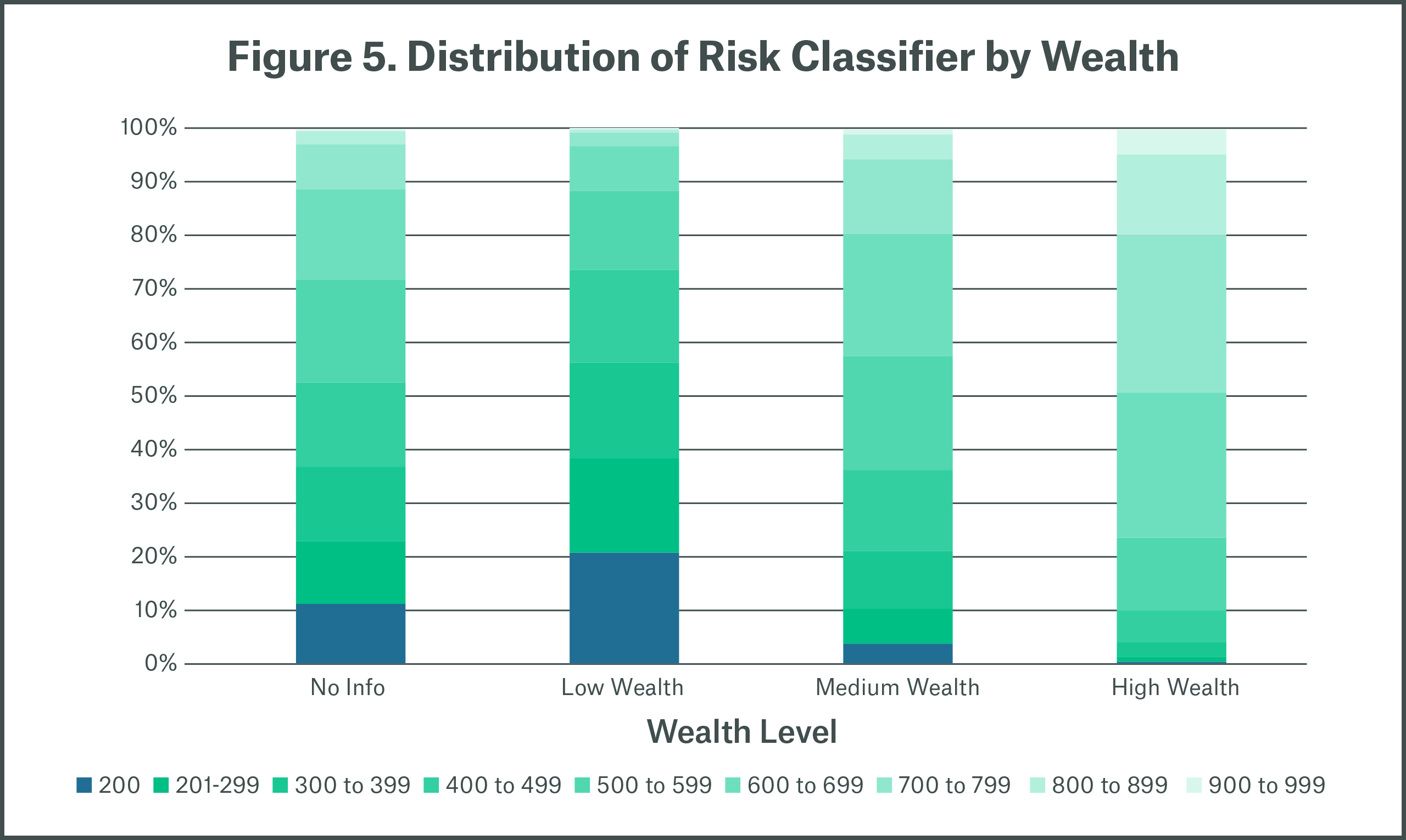
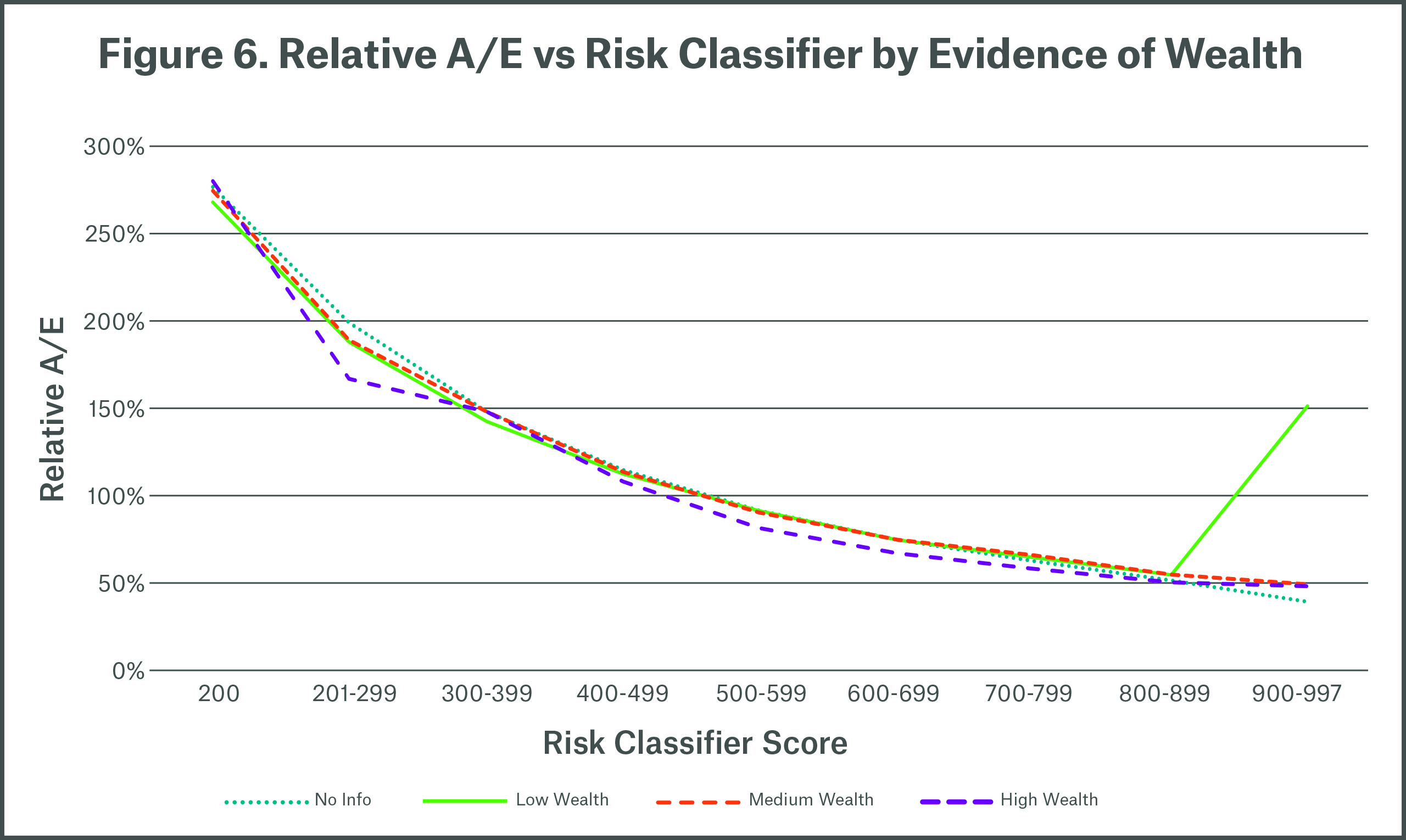
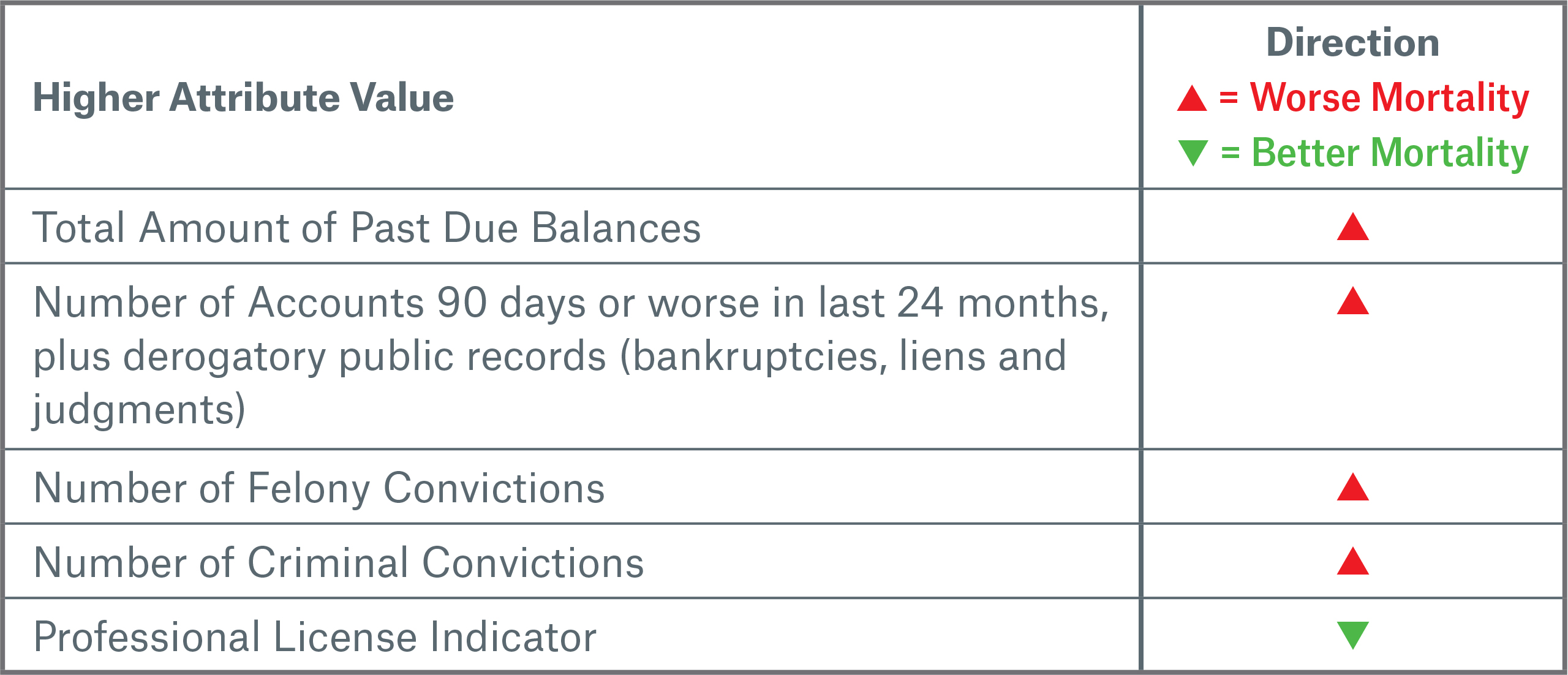
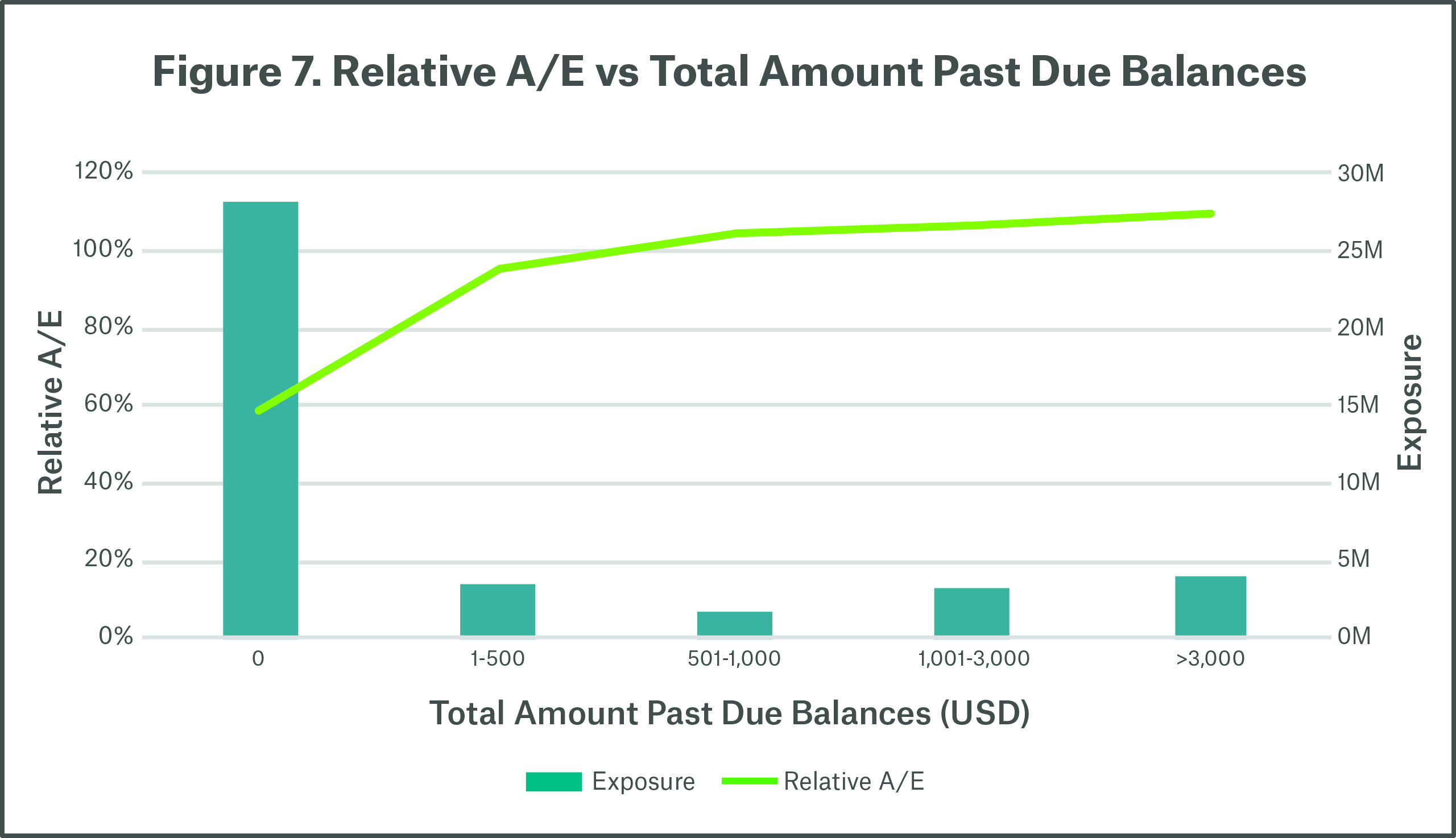
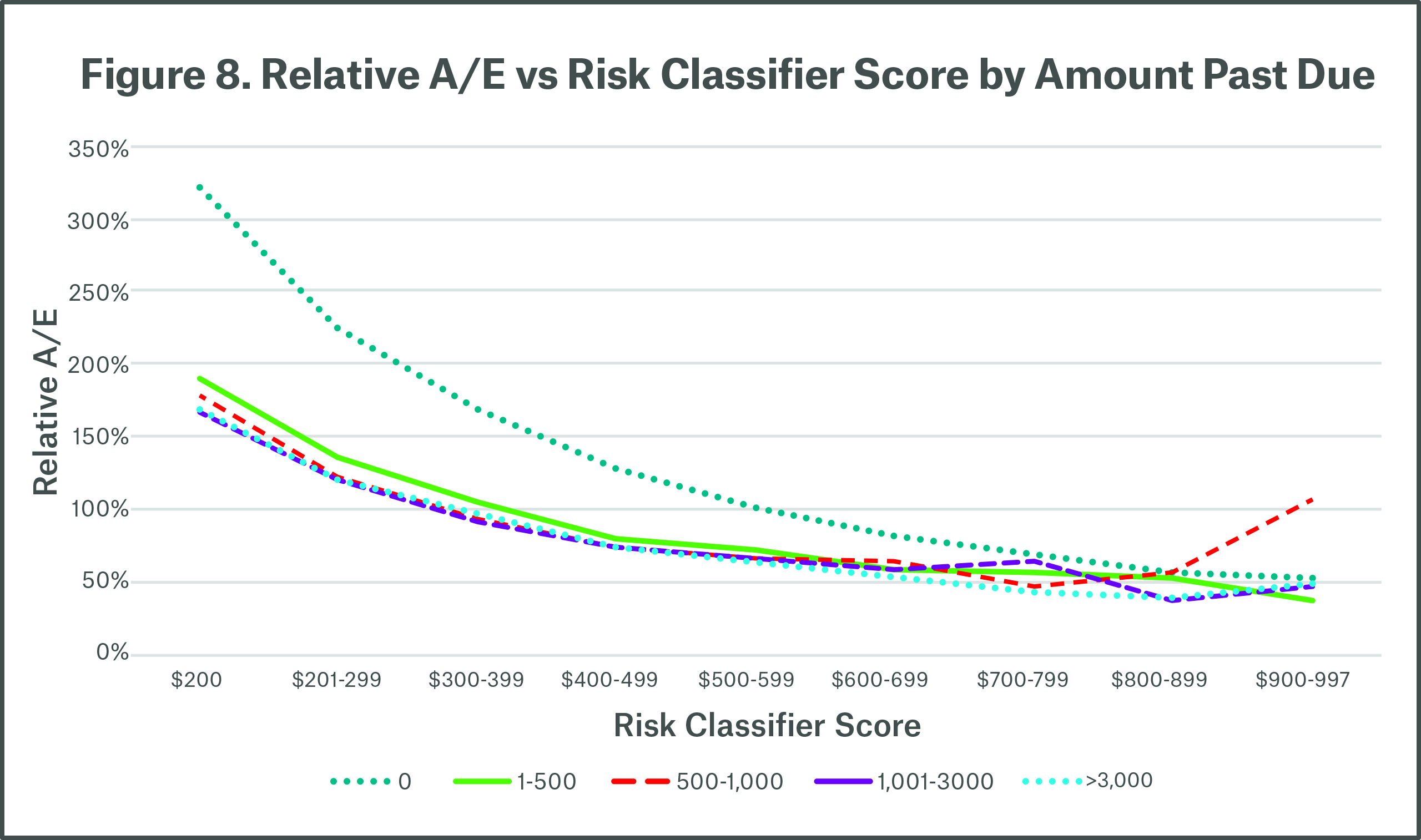
Summary
Munich Re concludes that LexisNexis® Risk Classifier is an effective predictor of mortality for the U.S. insurance applicant population. Risk Classifier stratifies mortality risk across various attributes. Furthermore, the analysis of wealth demonstrates that Risk Classifier effectively segments mortality across different wealth categories.
Insurers considering alternative data-based mortality scores should begin with a retrospective validation study on their own experience data to assess the impact of applying Risk Classifier to their unique target market, distribution and under-writing process. Munich Re can assist carriers with the retrospective study, advise on changes to mortality assumptions and recommend how to incorporate Risk Classifier in underwriting.
